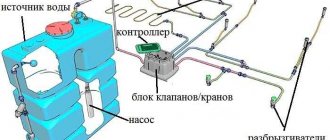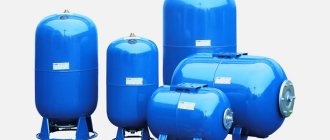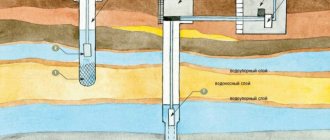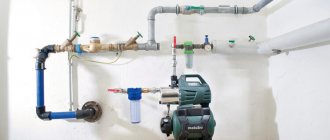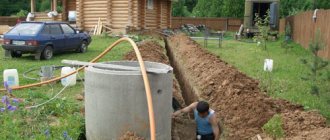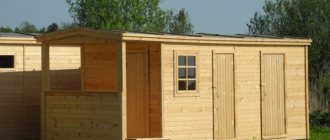Owners of an autonomous well must prudently prepare a shelter for it from external influences and attacks from intruders. A do-it-yourself well house will hide the equipment from prying eyes and provide sufficient thermal insulation. This option is especially relevant in a situation where the pumping station is installed on the surface. The functions of the building can be expanded by using it to store tools.
But it should be understood that such an external building may not fully protect the components and assemblies of the water supply system from external influences. For this, a caisson is used - a sealed container made of metal, plastic or other materials. The container has a hole in the lower part for the entry of the casing pipe, and at the top there is an opening for access to the well, which is hermetically sealed. You can build a caisson for a well with your own hands. But in some cases, installing a caisson is impractical - for example, if water is collected only in summer. In this case, a simple house will suffice.
Material selection and design
A country well with an open casing remains unprotected from external influences. If stones or small rodents get inside the well, it can ruin the operation of the pump. The safety of equipment is a separate matter; an expensive unit for lifting water can be lifted and stolen in the absence of the owners. To protect wells, ready-made metal containers are offered, but they will stand out unattractively on the site. To ensure that the appearance of the well house in the country is in harmony with the surrounding space, it is better to make it to your taste.
Metal box for well
The main materials for construction are wood and brick. The entire structure from the frame to the roof can be assembled from lumber. The brick will only be used for laying the walls; the roof structure will require wooden rafters and one of the roofing coverings.
Advice. Before starting work, timber and boards are treated with an antiseptic. This procedure will extend the life of the building.
To avoid any difficulties during construction, a house design is being prepared. It indicates the dimensions of the structure and the necessary materials. A simple and affordable option would be a frame building with a gable roof. Depending on the height of the structure, the well service door is placed on the wall or on the roof slope.

Wooden house for a well
Location of the pumping station on the surface.
Of course, you can put a pumping station at the top of a well or in a box (booth, house) at the exit of the well to the surface of the earth, but it seems to me that this is a purely summer, country option. The only advantage of this location is the accessibility of the pumping station, and not only to the owners. It is, to put it mildly, difficult to operate a pump located on the surface all year round. Although I know extreme sports enthusiasts who warmed the booth with the pumping station with an oil heater in winter so that it would not freeze. But why do you need the extra headache? It would be better to install a pumping station in the house and put up with its humming than to heat not only the pump, but also the pipes that go to the surface of the earth.
To summarize this article, I will say that, most likely, I will not “discover America” for anyone: the sooner you think about the water supply scheme for the house in general, and the placement of the pumping station in this scheme, the better the result will be and the fewer headaches you will have later , during the operation and maintenance of your equipment. Ideally, the station is up and running. Once a year we checked the pressure it creates using a pressure gauge, checked the air pressure in the hydraulic accumulator - that’s all the maintenance. I would really like this to be the case for you too.
You may be interested in similar materials::
- We assemble the pumping station ourselves. Hello, dear readers of “San Samych”. Today I would like to tell you about how it is possible to assemble a pumping station, and…
- Repair and operation of pumping stations. A pumping station is no longer just a pump with an electric motor, it is a set of equipment designed to supply water from a well, a well and…
- Hydraulic calculation for choosing a pumping station. Hello dear readers of “San Samych”. It’s funny sometimes to listen to sales consultants when they try to sincerely help you choose the “right” pumping station. Depth…
- So that the pump has enough water. Good day, dear readers of “San Samych”. A common problem when designing and operating a home water supply system based on a surface pump...
Frame construction
For construction you will need the following materials:
- dry timber 5×10 cm;
- board 10×2 cm;
- lining, block house or siding;
- slats;
- flexible tiles
The work of building a well house with your own hands begins with preparing the site. The area near the casing is leveled and compacted.
Advice. It is better to start arranging the house a few months after drilling the well. During this time, natural shrinkage of the soil will occur.
Frame assembly
The foundation for the building is prepared from various materials: paving stones, tiles used to pave the yard or a concrete foundation. The simplest and most affordable option is concreting corner supports.
- Places for placing timber are marked around the pipe. Pegs are driven into the support areas, then cords are pulled to determine the perimeter.
- Holes are dug 30 cm deep, the bottom is covered with sand 10-15 cm deep.
- The support pillars are inserted into the holes and secured with auxiliary material (stones) at the level. Filled with concrete.
- After hardening (3-4 days), the lower framing of the frame is performed. The beam is connected along the perimeter using metal corners and self-tapping screws.
- The next step is the top trim. It is performed similarly to the bottom one. For structural strength, you can install an additional vertical stand in the middle of each wall.
Sheathing
The choice of material for cladding depends on the owners. It can be lining, imitation timber or a block house, in the form of a rounded log. Sheathing slats are placed on the frame, and if necessary, waterproofing and insulation are laid on them. The casing is attached to the top with self-tapping screws.
Roof of the house
The standard option is a gable roof. To install it, it is necessary to create a rafter system. It consists of trusses - two boards are fastened at the ends at an angle of 30°. Their strength can be strengthened with a crossbar - a plank nailed 20 cm from the top of the truss. You will need two roof trusses. They are connected to each other by a ridge beam. On one of the slopes, two additional beams are nailed to the ridge, which form an opening for the door.
The sheathing is mounted on the rafters. The waterproofing is spread over it tightly. Roofing material is laid on top, for example, flexible tiles or ondulin.
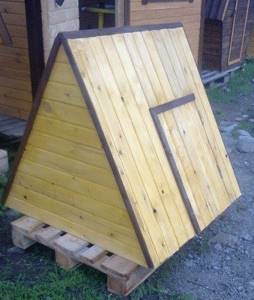
Roof for construction
Advice. For ease of well maintenance, some craftsmen make the roof removable.
Door
The design of the door is very simple, it is a panel made of boards. To make it, several boards 10-15 cm wide are laid, then in the upper and lower parts they are fastened with a block. There are 4 screws for each part. Reinforce the door with a diagonal strip. Metal loops are used for hanging.
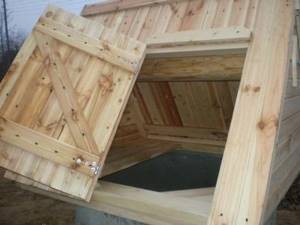
Door for the house
Common malfunctions in the operation of the station and their elimination
- The pump rotates, but no water enters the system. The cause of this malfunction is depressurization of pipelines; this situation also occurs due to incorrect operation of the check valve or lack of water in the system. To eliminate this problem, you need to check the presence of water in the system. If there is no water, it must be added through a special hole at the station or the depth to which the pump hose is lowered must be changed. If the problem persists after this, the valve and all connections must be checked for leaks. If this does not help, then you need to check the serviceability of the pump itself.

- The pump turns on very often and operates unevenly and jerkily. Most often, the cause of such a malfunction is damage to one of the parts of the hydraulic tank. There is a nipple on the back of the tank; if water flows after pressing it, then one of the pump membranes is torn and needs to be replaced. The cause of the malfunction may also be depressurization of the housing. If the described malfunctions are not found, then pumping air into the tank using a conventional pump can help solve the problem.
- The pump does not start. This often happens due to a lack of power. To eliminate the cause, you need to check the winding and contacts on the pressure switch.
- The pump turns on but does not rotate. The reason is a breakdown of the condenser, the impeller is stuck to the pump body. Often this situation occurs after a long break in the operation of the pump. To fix it, you need to turn the impeller several times by hand, but if this does not help, then the capacitor is broken and needs to be replaced.
- The pump operates continuously and does not pause in operation. The cause of this breakdown is a malfunction of the control relay. It must be adjusted using two springs located on the relay itself. The larger one regulates the minimum pressure, the smaller one regulates the difference between the lower and upper values. The cause may also be blockages at the relay inlet. All work with this pump part must be carried out very carefully.
How to install a pumping station yourself
Despite its apparent simplicity, the procedure for creating a pumping station is a rather complex process that requires the following requirements to be met:
- The flow rate of a well or well must be sufficient to provide all consumers with the required amount of water, even if they are all turned on at full capacity at the same time.
- The pipeline must have sufficient capacity so as not to create excess pressure in some nodes and not be insolvent at the outlet. The cross section is calculated based on the productivity of the water supply station.
- The productivity cannot be insufficient to lift water from the depth of the source to the surface and transmit it through pipes to the most distant consumer. Productivity – the amount of liquid pumped per hour.
To put it simply, a pumping station assembled with your own hands must ensure that consumption requirements meet the actual operating parameters. In this case, you need to place it correctly.
It is important that the source be in close proximity so that when in working order the station is able to quickly pump in the required amount of liquid.
The equipment is placed in a room, caisson or other place where there are no negative temperatures if it will operate all year round. In this case, it is necessary that all components are accessible for dismantling, repair and maintenance.
Rules for connecting a pumping station to a well
There is such a type of pipes as low-pressure polyethylene pipes, which have a high density. There are non-pressure ones for use in sewers and pressure ones for connecting to a water supply system. This type of pipe combines the easy installation of rubber hoses and the quality of plastic pipes.
The use of plastic pipes has a number of advantages over rubber hoses:
- React less to temperature changes;
- Better withstand pressure;
- More durable;
- Safer for drinking water.
These pipes can withstand pressures of up to 16 atm, which is sufficient for a pumping station used in a private home. The service life of pipes, when used correctly, is about 50 years. To connect a pumping station in a private house, you need to decide on its location.
The station must be located close to a well or borehole, or other source of water and subject to the recommendations of the technical characteristics of the equipment.
The room in which the installation will be located must be warm during the cold season and have ventilation to eliminate possible condensation. Since the system makes noise during operation, there is no need to place it near rest areas, and to suppress vibration, the system is placed on a rubber mat or a special shock-absorbing floor covering. For proper and uninterrupted operation of the pumps, it is necessary to maintain the tightness of the pipeline. It is possible to connect a water heater to the pumping station. To do this, you need to lay an additional pipe to the water heater.
